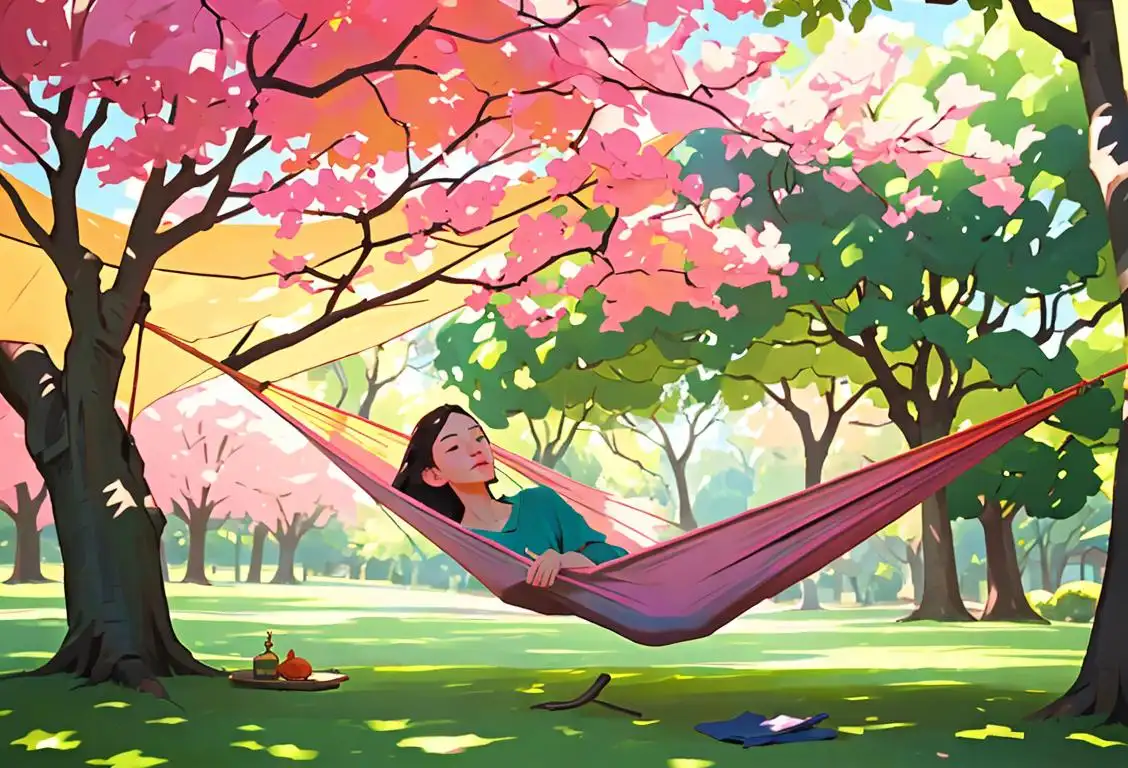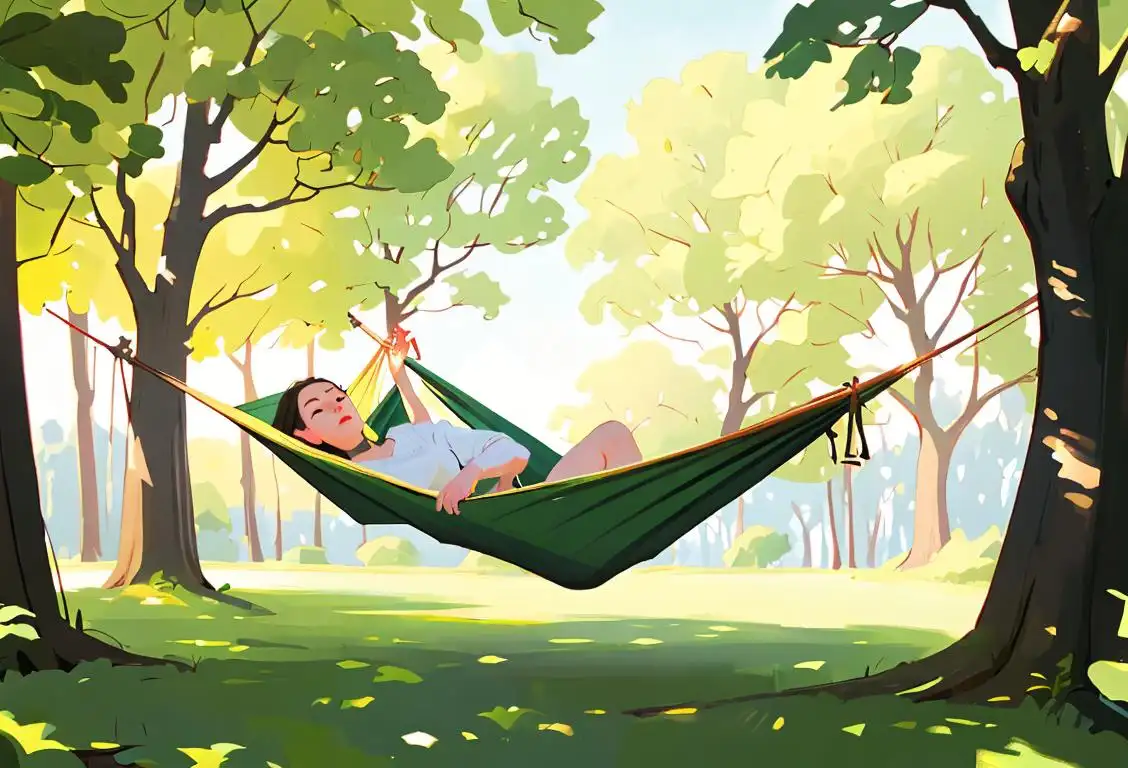National Hammocking Day

Ah, National Hammocking Day, a day to celebrate the art of hanging out and relaxing in a cozy hammock. Whether you're a professional hammocker or just a casual lounger, this national day is all about finding your inner sloth and enjoying the simple pleasure of swaying in the breeze. So grab your hammock, find the perfect spot, and let's dive into the fascinating internet history of this day!
When is Hammocking Day?
It's national hammocking day on the 22nd July.
The Origins of National Hammocking Day
Believe it or not, the origins of National Hammocking Day can be traced back to the rise of the digital age. As people spent more and more time in front of their screens, sitting in uncomfortable office chairs or hunching over their laptops, they started to yearn for a way to escape the stiffness and stress of the modern world.
Enter the humble hammock. With its gentle sway and cradle-like comfort, hammocks became a symbol of relaxation and leisure. People discovered that hammocking was the perfect antidote to the hustle and bustle of everyday life, allowing them to disconnect, unwind, and recharge their batteries.
Word of this magical escape quickly spread through online forums, social media, and blog posts, creating a community of hammock enthusiasts who dubbed themselves the 'Hammock Gang'. These trailblazers became the driving force behind the creation of National Hammocking Day, a day to celebrate the restorative power of hammocks and encourage others to embrace the hammock lifestyle.
How to Celebrate National Hammocking Day
Wondering how you can partake in the hammocking festivities? Fear not, we've got you covered with some awesome ideas:
- Find a picturesque spot: Whether it's your backyard, a local park, or a hidden gem in nature, scout out the perfect spot to set up your hammock.
- Invite your loved ones: Hammocking is even better when shared with the people you care about. Invite your friends, family, or that neighbor you've been trying to get to know.
- Indulge in hammock snacks: Treat yourself to some delicious snacks and beverages to enjoy while hammocking. From refreshing lemonade to tasty finger foods, the possibilities are endless.
- Read, nap, daydream: Let your imagination run wild in the hammock. Dive into a good book, take a peaceful nap, or simply let your mind wander as you watch the clouds float by.
Remember, the key is to relax and let go of any worries or stress. National Hammocking Day is all about finding your happy place, both physically and mentally.
History behind the term 'Hammocking'
1492
Discovery of the Hammock
In 1492, Christopher Columbus and his crew encountered the Taino people of the Caribbean, who were using a unique sleeping arrangement called a hammock. The Taino's hammocks were made from the bark of the Hamack tree and provided a comfortable and cool alternative to sleeping on the ground. Columbus was so impressed by this invention that he brought some hammocks back to Europe.
1492
Discovery of the Amerindians' 'maquiritare'
In 1492, when Christopher Columbus arrived in the Caribbean, he encountered the indigenous people who were already using a type of suspended bed called 'maquiritare.' Their beds were made of bark and fibers of the Hamack tree, providing a comfortable spot for relaxing and sleeping in the tropical heat.
1492
Discovery of the hammock
During Christopher Columbus's voyage to the Americas, he encountered indigenous people using a unique resting device called a 'hamaca.' These suspended beds made of tree bark or woven fibers allowed for better air circulation, providing relief from the hot and humid climate of the Caribbean.
1492
Indigenous Origins
The origins of hammocking can be traced back to the indigenous peoples of Central and South America, who created hammocks using materials such as tree bark, plant fibers, and animal skins. These early hammocks were practical sleeping surfaces designed to provide comfort and protection from the ground.
1492
The Encounter
In 1492, when Christopher Columbus landed in the Caribbean during his voyage, he encountered the indigenous Taino people relaxing in a unique way. They were resting in slings made of bark and plant fibers, suspended between trees. Intrigued by this new form of relaxation, Columbus took note of the natives' custom.
1492
Encounter with the Taino
In the year 1492, Christopher Columbus arrived in the Caribbean and encountered the Taino people, a native tribe known for their resourcefulness. The Taino had perfected the art of hammocking, using woven tree bark to create comfortable sleeping platforms suspended between trees.
1492
European Discovery
When Christopher Columbus arrived in the Americas in 1492, he encountered the indigenous people using hammocks for sleeping. Columbus and his crew were intrigued by this innovative design, noting its practicality and comfort compared to European bedding at the time.
16th Century
Spanish Influence on 'Hammaca'
As Columbus introduced hammocks to Europe, the Spanish explorers and sailors embraced this form of suspended sleeping. They were particularly fascinated by the word 'hamaca' used by the Taino people to describe their sleep contraption. The Spanish adopted this term and it gradually spread throughout Europe, ingraining itself in the Spanish language.
1670
The Hammock Arrives in Europe
About a century later in 1670, hammocks found their way to Europe. Sailors used them as a more comfortable alternative to cramped quarters on ships. These swinging beds quickly gained popularity among sailors and explorers due to their compactness, ease of use, and their ability to provide a comfortable sleep aboard a ship.
1518
Introduction to Europe
During the Spanish conquest of the Americas, hammocks were brought back to Europe as a novel marvel. Sailors on the ships marveled at the ingenious design and the comfort it provided, especially in the cramped conditions of the ship. The word 'hamaca' from the Taino language was introduced to Spanish vocabulary.
1590
Hammocks adopted by sailors
Sailors, including those from the Royal Navy, observed the practicality and comfort of the hammock while interacting with indigenous communities during their travels. The hammock's ability to sway with the ship's motion made it a perfect sleeping solution on board, as it kept sailors secure and prevented injury during rough seas.
1597
Introduction to Europe as 'hamaca'
The term 'hamaca' made its way to Europe through various explorers and travelers who had encountered the hammocks while exploring the Americas. The word was adapted from the Amerindian 'maquiritare' and entered the European lexicon as 'hamaca.'
17th Century
Spread throughout the World
As European powers explored and established colonies around the globe, the use of hammocks became more widespread. Sailors and explorers adopted hammocks for their practicality and ability to prevent injuries caused by rolling seas. The British Navy officially adopted hammocks for its sailors in the late 17th century.
17th century
Colonial Influence
Hammocks gained popularity among European explorers and settlers in the Americas during the 17th century. Sailors and soldiers found hammocks especially useful on ships and during military campaigns, as they provided a stable sleeping surface that could be easily stored. The ability to stay off the ground also protected against pests and dampness.
17th Century
Shipboard Usage and Sailors' Comfort
In the 17th century, hammocks gained popularity on ships due to their practicality and ability to maximize space. Sailors adopted hammocks as their sleeping quarters, where they could hang them from the ship's beams or stanchions. Hammocks provided a more stable and comfortable sleeping arrangement compared to slings or mats on the hard wooden decks.
1889
Hammocks as a Symbol of Leisure
By the late 19th century, hammocks had become a symbol of leisure and relaxation. As transportation and tourism began to flourish, people embraced the idea of lounging in hammocks while on vacation. This new trend was fueled by the development of portable hammocks, making them accessible to a wider audience.
17th Century
Hammocks for Naval Use
During the 17th century, hammocks gained popularity among sailors in the European naval fleets. In contrast to traditional beds that would swing unpredictably during rough seas, hammocks offered stability and comfort. The Navy widely adopted hammocks, especially among British and Dutch sailors, as a practical solution to sleeping on ships.
19th century
Hammocks on naval vessels
Hammocks became an essential part of life on naval vessels, both for sailors and officers. The use of hammocks maximized limited space on ships while providing a more comfortable rest option compared to traditional bunks or sleeping on hard surfaces. Their presence also contributed to improved hygiene by minimizing the contact sailors had with potentially infested bedding materials.
19th Century
Hammocks in the Tropics
The British military expanded its use of hammocks to their tropical colonies, especially in regions where sleeping on the ground was uncomfortable and posed risks from insects and predators. Subsequently, hammocks became popular in tropical regions around the world, providing a cooling and comfortable alternative to beds.
1920
Spreading to Backyards
In the 1920s, as the middle class grew and suburban homes with spacious backyards became more common, hammocks began to find their place outside of just ships and vacation spots. Backyards became a popular setting for hammocks, providing a serene space for relaxation, reading, or enjoying the outdoors.
19th Century
Hammock-Style Chairs and Relaxation
In the 19th century, an evolution of the hammock occurred, with the invention of hammock-style chairs. These chairs became a fashionable item for relaxation and were commonly found in gardens and leisure spaces. The comfort and design of the hammock chair allowed people to enjoy a suspended seating experience, promoting a sense of tranquility and luxury.
1889
American military adopts hammocks
The United States military adopted the use of hammocks during the Spanish-American War. The Army recognized their practicality and lightweight nature, allowing soldiers to rest off the ground in various terrains, such as jungles and marshes. The efficiency of hammocks in military contexts gradually grew, leading to their integration into standard equipment and training.
Early 19th century
Spread through Exploration
As exploration and trade expanded during the 19th century, hammocks became more widely known around the world. Explorers and adventurers, including botanists and naturalists, encountered hammocks during their travels and introduced them to their respective countries and cultures.
19th Century
Military Adoption in the Tropics
During the 19th century, hammocks were widely used in tropical colonies, particularly by the military. The British and Spanish forces, in particular, adopted the use of hammocks as their preferred sleeping arrangement in the hot and humid regions of their colonies.
20th Century
Leisure and Relaxation
In the 20th century, hammocking gained popularity as a symbol of leisure and relaxation. Hammocks were associated with tropical vacations and beachside lounging. They became sought-after outdoor furniture for people looking to create a tranquil oasis in their own backyard. Portable hammocks also became a staple for camping and hiking trips.
20th Century
Hammocks for Leisure and Recreation
In the 20th century, hammocks transitioned from a practical necessity to a symbol of relaxation and leisure. With the rise of tourism and the appreciation of outdoor activities, hammocks became synonymous with vacationing in tropical destinations and enjoying peaceful moments in nature.
20th century
Hammocks as a symbol of relaxation
During the mid-20th century, hammocks gained popularity as a symbol of leisure and relaxation. They became associated with vacation destinations, beach vibes, and lazy afternoons spent outdoors. Hammocks emerged as a trendy item for people to enjoy in their backyards, parks, and campsites, promoting a sense of tranquility and escape from the fast-paced modern world.
Late 19th century
Leisurely Relaxation
By the late 19th century, hammocks began to be associated with leisure and relaxation. They were embraced as a symbol of tropical vacations and exotic destinations. The association with leisure and tranquility led to the popularization of hammocks as outdoor furniture in gardens, backyards, and resorts.
1960
Hammocks in Popular Culture
During the countercultural movement of the 1960s, hammocks became an emblem of the relaxed and carefree lifestyle associated with hippie culture. As the ideal symbol of peaceful protest against societal norms, hammocks were often seen at music festivals, communal living spaces, and environmental gatherings.
20th Century
Hammocks for Recreation and Camping
As the camping and outdoor recreation culture grew in the 20th century, hammocks became a popular alternative to tents and sleeping bags. Hammocks provided a lightweight and convenient sleeping option for backpackers and adventurers. Their portability and ease of setup in various environments made them a staple of outdoor enthusiasts worldwide.
20th century
Modern Recreation
In the 20th century, the use of hammocks extended beyond tropical regions to become a worldwide recreational activity. Hammocks became popular among campers, hikers, and outdoor enthusiasts, providing a lightweight and portable sleeping option while also promoting relaxation and immersion in nature.
Present Day
Hammocking as a Lifestyle
Today, hammocking has become more than just a form of relaxation. It has evolved into a lifestyle and a popular activity embraced by people around the world. From backyard lounging to camping trips and music festivals, hammocks offer a comfortable and versatile way to enjoy the outdoors.
Present Day
Hammocking as a Leisure Activity
Today, hammocking has become synonymous with relaxation and leisure. People turn to hammocks to unwind, read a book, or simply enjoy nature's embrace. Whether it's on a beach, in a park, or even indoors, the hammock provides a peaceful cocoon-like experience. Hammock enthusiasts have formed communities, sharing tips and tricks, and celebrating the joy of hammocking.
Present
Hammocking Today
Today, hammocking has become a popular activity among outdoor enthusiasts and those seeking a serene escape. Hammocks are not only found in homes but also in parks, forests, and even indoors as a cozy alternative to traditional beds. This simple and versatile invention continues to provide a comfortable haven for relaxation, embodying the spirit of leisure and tranquility.
Did you know?
Did you know that the world record for the longest continuous hammock session is over 11 hours?! That's right, someone actually stayed in a hammock for more than half a day. Talk about dedication to relaxation!Tagged
fun loved ones relaxationFirst identified
22nd July 2015Most mentioned on
22nd July 2020Total mentions
10Other days
Ewa Beach Day
Pampering Day
Bathtub Party Day
Fl Day
Lie Around At Home In Your Pajama Pants Day
Slowdown Day
Drop Everything And Read Day
Eat Outside Day
Healing Day
Nap Nap Day







